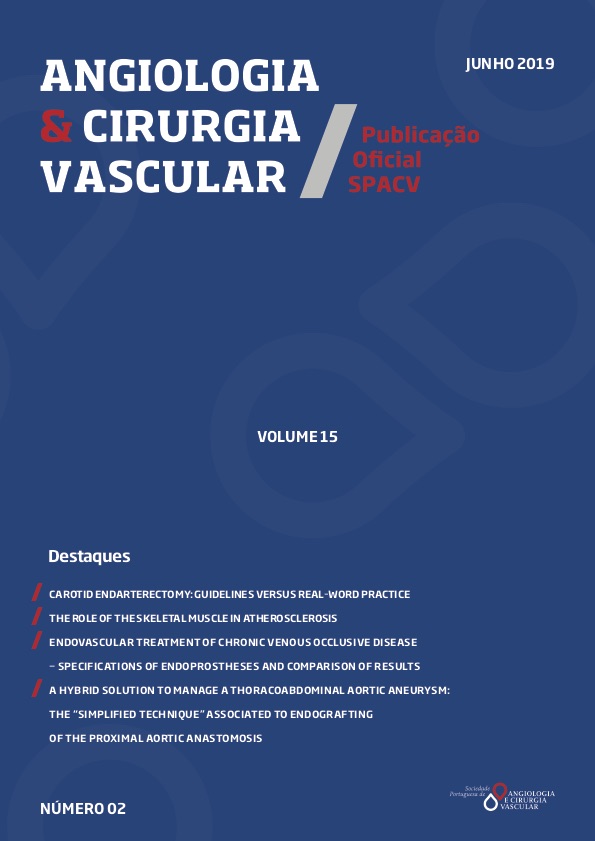PAPEL DO MÚSCULO ESQUELÉTICO NA ATEROSCLEROSE
DOI:
https://doi.org/10.48750/acv.220Palavras-chave:
Músculo esquelético, Aterosclerose, Sarcopenia, Doença arterial periférica, Doença coronária, Doença carotídeaResumo
O papel da obesidade visceral na doença aterosclerótica está bem definido. Pelo contrário, a importância do músculo esquelético não está completamente esclarecido. O músculo é entendido hoje, como um órgão endócrino produtor de mioquinas com uma acção direta em vários mecanismos fisiológicos e fisiopatológicos, incluindo a aterosclerose. As mioquinas reduzem a produção da neo-íntima, a expressão de mediadores inflamatórios, o recrutamento de células inflamatórias e a formação de “foam cells”. Os estudos epidemiológicos demonstram uma associação entre a redução da massa muscular e a doença cardiovascular. A baixa massa muscular está associada a aumento da prevalência da doença coronária, calcificação aórtica, aterosclerose carotídea, espessamento média-íntima, estenose das artérias cerebrais e disfunção endotelial. Deste modo, os exercícios de resistência, que causam hipertrofia muscular e aumentam a foça muscular, podem ter um papel na aterosclerose. A ingestão proteica, em particular pelos idosos parece ser crítica para a manutenção da massa muscular e para aumentar a sobrevivência. O objetivo deste artigo é proceder a uma revisão da literatura relativamente ao papel musculo esquelético na aterosclerose.
Downloads
Referências
2. Pedersen BK, Brandt C. The role of exercise-induced myokines in muscle homeostasis and the defense against chronic diseases. J Biomed Biotechnol. 2010. doi:10.1155/2010/520258
3. Li F, Li Y, Duan Y, Hu CAA, Tang Y, Yin Y. Myokines and adipokines: Involvement in the crosstalk between skeletal muscle and adipose tissue. Cytokine Growth Factor Rev. 2017;33:73-82. doi:10.1016/j.cytogfr.2016.10.003
4. Ko BJ, Chang Y, Jung HS, et al. Relationship between low relative muscle mass and coronary artery calcification in healthy adults. Arterioscler Thromb Vasc Biol. 2016. doi:10.1161/ATVBAHA.116.307156
5. Freitas WM, Carvalho LSF, Moura FA, Sposito AC. Atherosclerotic disease in octogenarians: A challenge for science and clinical practice. Atherosclerosis. 2012;225(2):281-289. doi:10.1016/j.atherosclerosis.2012.06.070
6. Alexandersen P, Christiansen C. Associations between Aortic Calcification and Components of Body Composition in Elderly Men. 2006;14(9):1571-1578.
7. Buford TW, Anton SD, Judge AR, et al. Models of accelerated sarcopenia: Critical pieces for solving the puzzle of age-related muscle atrophy. Ageing Res Rev. 2010. doi:10.1016/j.arr.2010.04.004
8. Ouchi N, Ohashi K, Shibata R, Murohara T. Protective Roles of Adipocytokines and Myokines in Cardiovascular Disease. Circ J. 2016;80(10):2073-2080. doi:10.1253/circj.CJ-16-0663
9. Kim TN, Choi KM. Sarcopenia : Definition , Epidemiology , and Pathophysiology. 2013:1-10.
10. Hida T, Imagama S, Ando K, et al. Sarcopenia and physical function are associated with inflammation and arteriosclerosis in community-dwelling people: The Yakumo study. Mod Rheumatol. 2018. doi:10.1080/14397595.2017.1349058
11. Dionne IJ, Dionne IJ. Risk Factors and Chronic Disease Effect of Sarcopenia on Cardiovascular Disease Risk Factors in Obese Postmenopausal Women. 2006;14(12):2277-2283.
12. Li F, Li Y, Duan Y, Hu CA, Tang Y, Yin Y. Cytokine & Growth Factor Reviews Myokines and adipokines : Involvement in the crosstalk between skeletal muscle and adipose tissue. Cytokine Growth Factor Rev. 2017;33:73-82. doi:10.1016/j.cytogfr.2016.10.003
13. Askari H, Rajani SF, Poorebrahim M, Haghi-Aminjan H, Raeis-Abdollahi E, Abdollahi M. A glance at the therapeutic potential of irisin against diseases involving inflammation, oxidative stress, and apoptosis: An introductory review. Pharmacol Res. 2018;129:44-55. doi:10.1016/j.phrs.2018.01.012
14. Ochi M, Kohara K, Tabara Y, et al. Arterial stiffness is associated with low thigh muscle mass in middle-aged to elderly men. Atherosclerosis. 2010;212(1):327-332. doi:10.1016/j.atherosclerosis.2010.05.026
15. Morley JE, Kim MJ, Haren MT, Kevorkian R, Banks WA. Frailty and the aging male. Aging Male. 2005. doi:10.1080/13685530500277232
16. Campos AM, Moura FA, Santos SN, Freitas WM, Sposito AC. Sarcopenia, but not excess weight or increased caloric intake, is associated with coronary subclinical atherosclerosis in the very elderly on behalf of Brasilia Study on Healthy Aging and Brasilia Heart Study. Atherosclerosis. 2017:1-7. doi:10.1016/j.atherosclerosis.2017.01.005
17. Bano G, Trevisan C, Carraro S, et al. Maturitas Inflammation and sarcopenia : A systematic review and meta -analysis. Maturitas. 2017;96:10-15. doi:10.1016/j.maturitas.2016.11.006
18. Hida T, Imagama S, Ando K, et al. Sarcopenia and physical function are associated with inflammation and arteriosclerosis in community-dwelling people : The Yakumo study. Mod Rheumatol. 2017;0(0):1-6. doi:10.1080/14397595.2017.1349058
19. Nakano R, Takebe N, Ono M, et al. Involvement of oxidative stress in atherosclerosis development in subjects with sarcopenic obesity Obesity Science & Practice. 2017;(5). doi:10.1002/osp4.97
20. Hoffmann C, Weigert C. Skeletal muscle as an endocrine organ: The role of myokines in exercise adaptations. Cold Spring Harb Perspect Med. 2017. doi:10.1101/cshperspect.a029793
21. Ferro G, Basile C, Liguori I, et al. NU SC. EXG. 2016. doi:10.1016/j.exger.2016.09.007
22. Jung HJ, Jung H, Lee T, et al. Decreased muscle mass in Korean subjects with intracranial arterial stenosis: The Kangbuk Samsung Health Study. Atherosclerosis. 2017. doi:10.1016/j.atherosclerosis.2016.05.003
23. Lee JSW, Auyeung TW, Kwok T, Lau EMC, Leung PC, Woo J. Associated factors and health impact of sarcopenia in older Chinese men and women: A cross-sectional study. Gerontology. 2008. doi:10.1159/000107355
24. Jensky NE, Allison MA, Loomba R, et al. Null association between abdominal muscle and calcified atherosclerosis in community-living persons without clinical cardiovascular disease: The multi-ethnic study of atherosclerosis. Metabolism. 2013. doi:10.1016/j.metabol.2013.06.001
25. Mazza C, Barbe C, Perrier M, Botsen D, Renard Y. Feasibility of Systematic Handgrip Strength Testing in Digestive Cancer Patients Treated With Chemotherapy : The FIGHTDIGO Study. 2017:1-6. doi:10.1002/cncr.31207
26. Shimizu Y, Sato S, Koyamatsu J, et al. Handgrip strength and subclinical carotid atherosclerosis in relation to platelet levels among hypertensive elderly Japanese. Oncotarget. 2017. doi:10.18632/oncotarget.20618
27. Matsubara Y, Matsumoto T, Aoyagi Y, et al. Sarcopenia is a prognostic factor for overall survival in patients with critical limb ischemia. J Vasc Surg. 2015;61(4):945-950. doi:10.1016/j.jvs.2014.10.094
28. Matsubara Y, Matsumoto T, Aoyagi Y, Tanaka S. Sarcopenia is a prognostic factor for overall survival in patients with critical limb ischemia. J Vasc Surg. 2015;61(4):945-950. doi:10.1016/j.jvs.2014.10.094
29. Morley JE. Diabetes , Sarcopenia , and Frailty. 2008;24:455-469. doi:10.1016/j.cger.2008.03.004
30. Pedersen BK. Muscles and their myokines. J Exp Biol. 2011. doi:10.1242/jeb.048074
31. Barazzoni R, Bischoff SC, Boirie Y, Busetto L, Yumuk V, Vettor R. Sarcopenic obesity : Time to meet the challenge. Clin Nutr. 2018;(May):1-7. doi:10.1016/j.clnu.2018.04.018
32. Lee MJ, Lee SA, Nam BY, et al. Irisin, a novel myokine is an independent predictor for sarcopenia and carotid atherosclerosis in dialysis patients. Atherosclerosis. 2015;242(2):476-482. doi:10.1016/j.atherosclerosis.2015.08.002








